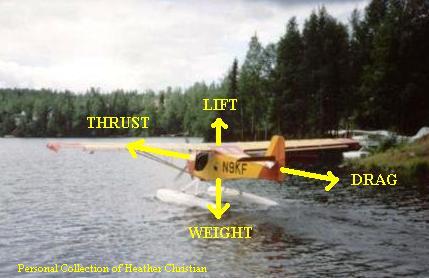

Lift is generated by the air flow around the plane's wing. This effect is explained mostly by Bernoulli's Principle which states that the pressure of the air decreases as the velocity of the air increases. The design of a plane's wing changes the airflow around the wing's surface. The air has farther to travel over the top of the wing than the air traveling below the wing. Therefore, the air traveling above the wing is traveling at a higher velocity than the air traveling below it. As air flows around the wing, a high pressure region with low air velocity is created below the wing, and a low pressure region with high air velocity is created above the wing. The difference between the two pressures generates the lift force. (JEPPESEN 1-11)
Newton's third law, stated above, explains how the remaining lift force is produced. Lift is generated when the air hits and is deflected off of the underside of the wing. This deflection of air downwards, in turn, causes an upward lift force on the wing since there must be an "equal and opposite reaction force."(Newman) This force accounts for a relatively small portion of the total lift generated for a wing.(JEPPESEN 1-13)
Weight is one of the opposing forces to lift. From Newton's second law, the weight of an object is the magnitude of the force of gravity on that object. Weight can be found by the equation F=mg. Where "F" is the force of gravity, "m" is the mass of the object, and "g" is the acceleration of gravity toward the center of the Earth. Weight always acts in the direction of the center of the Earth. (Serway, et al. 119)
The force that pulls the airplane forward is known as thrust. The propulsion system of an airplane generates thrust in order to overcome the drag force. Since it is closely tied to the propulsion systems of an aircraft, thrust will be discussed in more detail in the section titled "Take Off."(NASA)
The main opposing force to thrust is the drag force. Drag acts in the opposite direction of flight and is caused mainly by air resistance. Many factors affect the magnitude of the drag force. These factors include, but are not limited to: airspeed, angle of attack, and wing surface area.(JEPPESEN 1-21)
Home| Pre-Flight| Take Off| MayDay| Landings| References